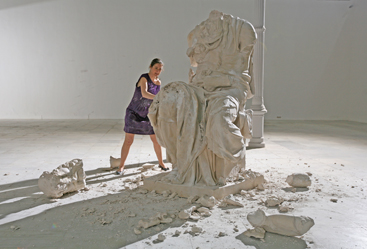
Born in 1973 in Jaén (ES). Lives and works in Asmterdam (NL) and Madrid (ES)

2008
HD video, 16/9, colour, sound
Durée : 7'
Year of Purchase: 2010
As by subtracting, my lady, one creates from rugged mountain stone an image of flesh and bone
developing even as the stone grows less[…].
Michelangelo Buonarroti (trans. John Frederick Nims)
Having reached the same age as Christ when he was crucified, Hungarian geologist László Toth celebrated Easter in 1972 by attacking Michelangelo’s Pieta with a hammer: he shattered an arm, chipped the veil, and broke the statue’s nose and an eyelid. Claiming to be Jesus risen from the dead, he argued that the eternity of the Christian god is antithetical to having a mother. A generation later, Cristina Lucas attacked with a sledge hammer a plaster reproduction of Moses, another figure shaped by the hand of the sculptor from Arezzo. Embodying the most inflammatory fantasies of the Guerrilla Girls, this gesture is openly hostile towards sexual, social, and religious domination represented by patriarchy. If it evokes the image of the vandal depicted by Francisco de Goya in his No sabe lo que hace, the artist’s iconoclasm does not derive from a religious or revolutionary heritage: sublimated by the language of cinema, it is situated within the context of the museum. A long static shot of the Michelangelo sculpture opens the film and seems to attest to the hieratic virility over which much ink has been spilled by art historians such as Burckhardt, Thode, or Wölfflin. Freud’s contemporaries, they interpreted the sculpture as the moment when, suspending his own iconoclastic gesture (the destruction of the golden calf), the bearer of the Decalogue hears the rumble of the idolatrous crowd. The figure of Moses decorating the tomb of Pope Julius II was not the only victim of the young woman’s “hysteria”: Freud’s 1914 essay, The Moses of Michelangelo also seems under fire. In this essay, the patriarch of psychoanalysis evokes his disappointment when, upon his visits to San Pietro in Vincoli, he would sit in front of the marble statue in the hope of seeing it move without anything ever happening, and admits to a need to understand, in an analytic way, the emotion inspired by a work of art before he can enjoy it.
Wearing a purple satin dress and ballet flats, Lucas doesn’t take the Roman steps of Corso Cavour: through a gateway flooded with light, she makes a decisive entry into a room circumscribed with white picture rails at the Museo Reina Sofia in Madrid. The movement of the camera starts with the destruction of the idol. A knee and the toga are the first victims of the assault. Then Lucas climbs onto the colossus and, her face strained with the effort but smiling jubilantly, deals a series of small blows onto the head and the horns of Moses, his curly hair, and his nose. She then circulates around the prophet, measures and contemplates him, caresses him: the left arm and the Tables of Law give way, shards of plaster come crashing onto the marble. Beneath the vertical light streaming from the skylights, the ideal figure that Michelangelo teased out of stone has whittled away to nothing. A pause precedes the final decapitation. The vain idol does not respond to the injunction contained in the title: Habla, that is, “Speak!” Poised on the knees of her mute victim, the artist seems to put an end to Sigmund Freud’s unsatisfied expectation: “No quiere decir nada. No habla. No hay respuesta.” The only trace that remains is the seated bust, cradled by soothing, melancholic notes, while the camera lens pulls away and everything fades into darkness.
Arnaud Dejeammes